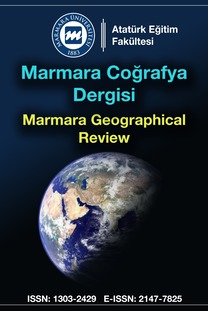Coğrafi Bilgi Sistemlerinin Yüksek Öğretim Coğrafya Eğitimi ile Entegrasyonu: Başarılı Uygulamalar İçin Bir Yol Haritası
Coğrafi Bilgi Sistemleri (CBS) akademik araştırmalarda mekânın çok yönlü incelenmesine imkan vermesi, öğrencilere mezuniyet sonrasında iş ve kariyer sağlamada büyük fırsatlar sunması, bölüm ve üniversitelere proje yolu ile maddi kaynak sağlaması gibi avantajları sebebiyle günümüzde pek çok ülkede coğrafya bölümlerinin ayrılmaz bir parçası haline gelmiştir. ABD, İngiltere ve Kanada gibi bazı gelişmiş ülkelerde 20 yılı aşkın bir süredir eğitim amaçlı olarak da kullanılan CBS’nin Türkiye’de coğrafya bölümlerinde kullanılması günümüzde istenilen seviyenin çok altındadır. Maddi imkansızlıklar ve yetişmiş eleman azlığının bu durumun ortaya çıkmasında etkili olduğu şüphesizdir. Ancak CBS ile coğrafya eğitiminin entegrasyonunun amaç, metot ve uygulamalar açısından ne şekilde yapılacağı konusunda ülkede yeterli sayıda örneğin olmamasının da bu durum üzerinde etkili olduğu görülmektedir. Bu çalışma CBS’nin yüksek öğretim coğrafya eğitimi ile yurtdışında nasıl entegre edildiğinin araştırılmasını amaçlamıştır. Bu açıdan ABD’de CBS’yi eğitim ve araştırma amaçlı olarak programlarına başarı ile adapte etmiş bulunan 5 coğrafya bölümü coğrafya programları, CBS dersleri ve altyapıları itibari ile incelenmiştir. Çalışma sonucunda incelenen coğrafya bölümlerinde CBS’nin bölüm programları ile entegrasyonunun öğrenci, öğretim elemanı, bölüm ve üniversitenin çok yönlü menfaatleri dikkate alınarak yapıldığı görülmüştür.
Integration of Geographic Information Systems into Geographic Education at Higher Education Institutions: A Road Map for Successful Applications
Geographic Information Systems (GIS) has now become an inseparable part of geography departments in many countries because it is a very important tool to make spatial analysis in academic studies, it provides students with many apportunities to find a better job and better academic career conditions, and it is a source of money for departments and universities. Although GIS has been used for educational purposes in some developed countries like the US, England, and Canada over the last two decades, its overall use in geography departments in Turkey is far below the satisfactory level. There is no doubt that lack of resources and trained academic stuff are the main reasons behind this situation. However, lack of proper examples in the country showing how to entegrate GIS into the current geographic education in terms of aim, methods, and applications has also been responsible for that. The aim of this study is to investigate how GIS has been integrated into geographic education at higher education institutions abroad. Five geography departments which GIS has been successfully integrated into their geography programs in the US have been investigated in terms of their curriculum, GIS courses and infrastructure. The study reveals that the integration of GIS into the geography programs at five departments has been made by considering the benefits of students, academic stuff, departments, and universities.
___
Beddıngfıeld, K.T., Bennefıeld, R.M., Chetwynd, J., ITO, T.M., POLLACK, K. & WRIGHT, A.R. (1995). 20 hot job tracts. U.S. News and World Report, 30 October, 98-108.Bednarz, S. W. (2004). Geographic Information Systems: A Tool to Support Geography and Environmental Education? GeoJournal 60, 191–199.
Birkin, M., Clarke, G., Clarke, M. & Wılson, A. (1996). Intelligent GIS: Location Decisions and Strategic Planning. GeoInformation International, Cambridge.
CASA. (2007). GIS Timeline, Center for Advanced Spatial Analysis http://www.casa.ucl.ac.uk/gistimeline/
Chen, X.M. (1998). Integrating GIS Education with Training: A Project-Oriented Approach. Journal of Geography 97(6), 261-268.
Cook, W.J., Collıns, S., Flynn, M.K., Guttman, M., Cohen, W. & Budıansky, S. (1994). 25 Breakthroughs that are Changing the Way We Live and Work. U. S. News and World Report, 2 May, 46-60.
Daratech. (2004). IT Market Research and Technology Assessment for Manufacturing, Engineering, Construction and Plant Operations, Daratech Inc., http://www.daratech.com/ press/2004/041019.
Demirci, A. (2004). İlk ve Ortaöğretim Coğrafya Eğitimi ve Coğrafi Bilgi Sistemleri: Fiziki Coğrafya (deprem ve volkanlar) Konusu ile İlgili CBS Tabanlı Örnek Bir Ders Uygulaması. 3. Coğrafi Bilgi Sistemleri Bilişim Günleri Bildiriler Kitabı, Fatih Üniversitesi Yayınları 19, 171-182, İstanbul.
Dıbıase, D., Demers, M., Johnson, A., Kemp, K., Luck, A.T., Plewe, B., & Wentz, E. (Ed). (2006). Geographic Information Science & Technology: Body of Knowledge, USGIS, Association of American Geographers, Washington, DC.
Fıtzpatrıck, C., Maguıre, D. J. (2000). GIS in Schools: Infrastructure, Methodology and Role. In D. R. Green (Ed.), GIS: A sourcebook for schools (pp. 61-62). Taylor & Francis.
Johansson, T. (Ed). (2006). GISAS project: Geographical information systems applications for Schools. Finland: University of Helsinki.
Kıng, G.Q. (1991). Geography and GIS Technology. Journal of Geography, 90(1), 66—72.
Lemberg, D., Stoltman, J.P. (2001). Geography Teaching and the New Technologies: Opportunities and Challenges. Journal of Education, 181, 63-76, Boston University.
Lloyd, W. J. (2001). Integrating GIS into the Undergraduate Learning Environment. Journal of Geography, 100(5), 158-163.
Mcadams, A., M., Demirci, A. (2004). Interdisciplinary Programs in Geographic Information Science: A “Road Map” for the Development of a Successful GISci Program at Higher Education Institutions. III. Coğrafi Bilgi Sistemleri Bilişim Günleri Bildiriler Kitabı, Fatih Üniversitesi Yayınları 19, 357-364, İstanbul.
NCGIA. (1999). The GIS History Project, http://www.ncgia.buffalo.edu/ gishist/bar_harbor.html
Patterson, M., Reeve, K., & Page, D. (2003). Integrating Geographic Information Systems Into the Secondary Curricula. Journal of Geography, 102(6), 275-281.
Taş, H. T. (2004). Günümüzde Yüksek Öğretim Kurumlarında CBS Eğitiminin Durumu ve Farklı CBS Eğitim Metotları. III Coğrafi Bilgi Sistemleri Bilişim Günleri Bildiriler Kitabı, Fatih Üniversitesi Yayınları 19, 393-401, İstanbul.
Whıte, K. L. & Sımms, M. (1993). Geographic Information Systems as an Educational Tool. Journal of Geography 92(2), 80-85.
Yomralıoğlu, T. (2000). Coğrafi Bilgi Sistemleri: Temel Kavramlar ve Uygulamalar, Seçil Ofset, İstanbul.
Zhou, Y., Smıth, B.W., Spınellı, G. (1999). Impacts of Increased Student Career Orientation on American College Geography Programmes. Journal of Geography in Higher Education 23, 157-165.
- ISSN: 1303-2429
- Yayın Aralığı: Yılda 2 Sayı
- Başlangıç: 1997
- Yayıncı: Marmara Üniversitesi
Sayıdaki Diğer Makaleler
Gevaş Kasabası ve Fonksiyonları
FARUK ALAEDDİNOĞLU, EMİN TOROĞLU, Mesut ELİBÜYÜK
Trabzon Havalimanı'na Coğrafi Bir Yaklaşım
Çanakkale Boğazı Petrol Kirlilik Düzeyinin Saptanması
Avrupa Birliği'ne Uyum Sürecinde Türkiye'deki Tarımsal İşletmelerin Günümüzdeki Durumu
Eşme (Uşak) Civarında Bazı Coğrafi Gözlemler
XVI. Yüzyılda Manisa Şehrinin Nüfus Özellikleri
Türkiye'de Ortaöğretim Coğrafya Derslerinde Teknoloji Kullanımı
